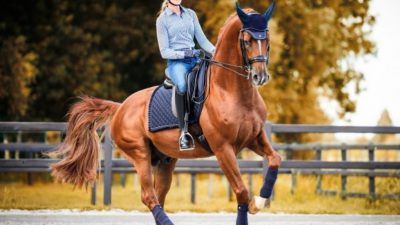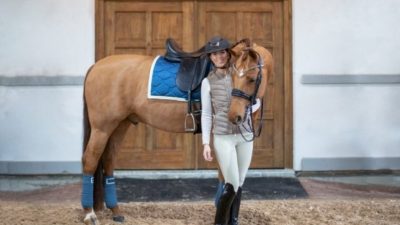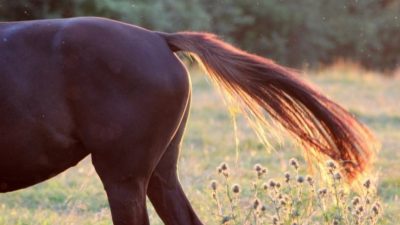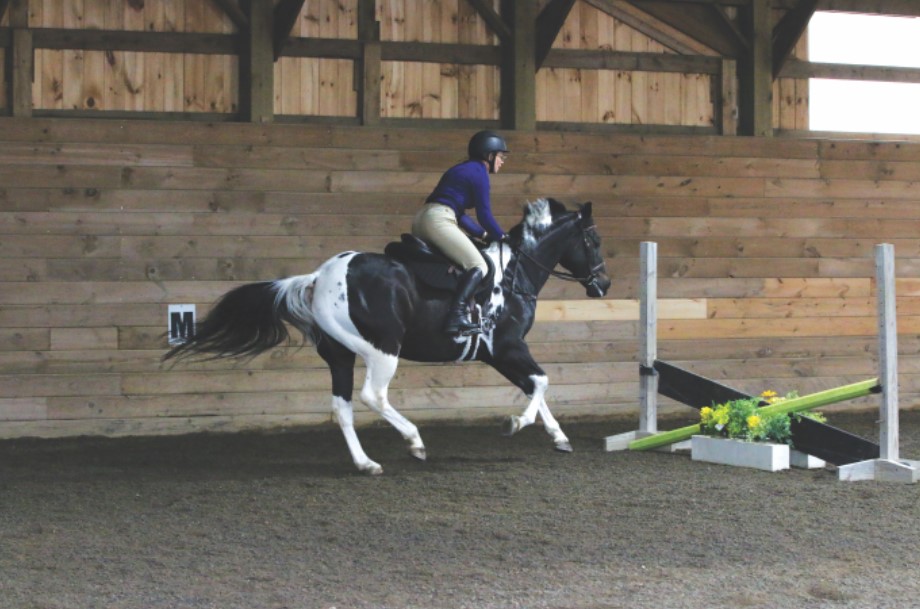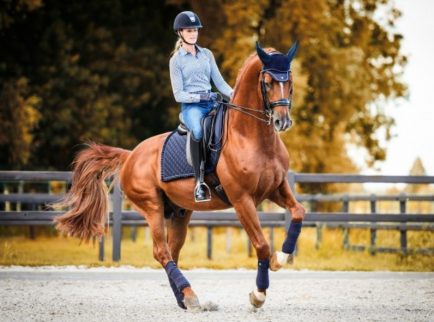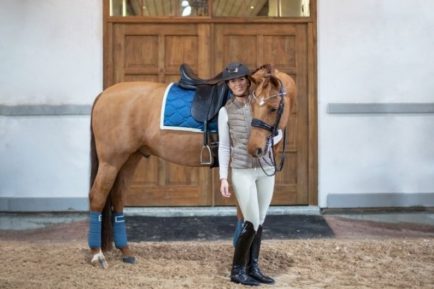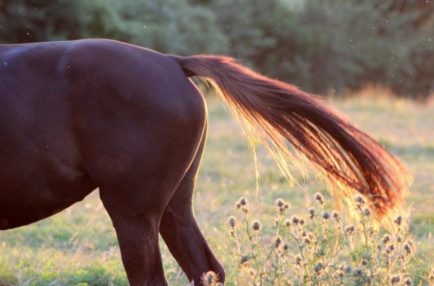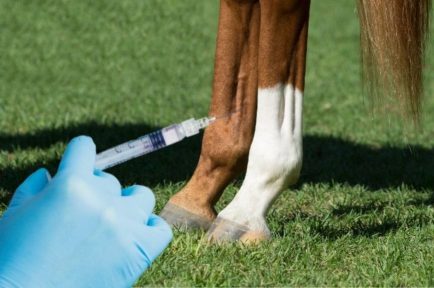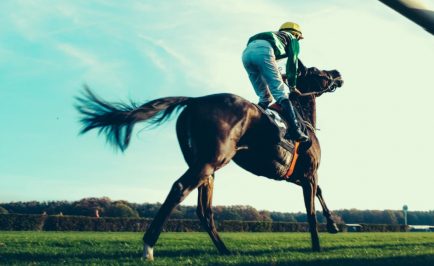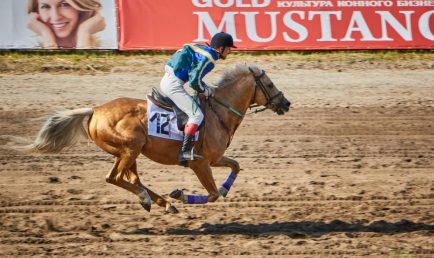Graystone Stables in Berwick, Maine, buzzed with early-morning activity: Terry Golson, 62, rubbed a manure stain off her black-and-white Paint. Katie Plaisted, 15, briefly longed a pony in the outdoor ring. Ten-year-old Ryen McDaniel and a group of riders, trainers and auditors lugged jump poles, standards and jump filler into the indoor arena.
The reason for the effort? The arrival of Olympic show jumper Margie Engle.
A dressage rider, Golson had entered Practical Horseman’s contest, “Win a Day with Margie Engle,” as a way to give back to other boarders, mainly teenage girls, at Jason Ludwick’s hunter/equitation boarding facility. The young adults had cheered on Golson after she arrived at the barn in 2019 and had started to jump with her American Paint Horse Association-registered Tonkas Midnight Snow.
“Winning this was really a gift to the people at the barn who welcomed me here and brought me into their world of hunter/jumper shows and the jumping, and the kids are great,” said Golson, who won the contest, sponsored by Equimax (a Bimeda dewormer), out of nearly 550 entrants. Engle selected Golson because in her essay she spoke about how the young riders at the barn were involved in all aspects of horsemanship from grooming to cleaning tack to sweeping the barn aisles.
The clinic, held last spring after a year’s delay because of COVID-19, was divided into four sessions, with jumping heights ranging from 18 inches to 3 feet. Engle arrived shortly before 9 a.m. and the lessons began. Despite the differences in skill levels, horse type and fence heights, Engle structured the lessons similarly: flatwork with a focus on transitions; riding two poles on the ground in five, six and four strides; and jumping lines or a small course that included a one-stride trot gymnastic and a bounce.
One overall training theme emerged with all of the sessions: Use more leg. As Engle repeated throughout the day, “You can never use enough leg.”
Following are five exercises that Engle shared with the riders. Continue reading at the bottom of this article for seven additional tips.
Exercise 1: Lengthen and Collect the Trot
After a brief warm-up where riders stayed on the arena rail and encouraged their horses to trot forward, Engle had them lengthen on long sides of the arena in posting trot, then collect on the short ends in sitting trot.
To lengthen, Engle encouraged riders to use their legs and seats to drive the horses forward into a light connection. To collect, she told them to first use their legs and seats to engage the horses from behind. “Leg and seat before hand,” she said, emphasizing that she wanted to see a difference in stride lengths.
One goal of the work was getting the horses listening to the riders’ aids. Another was to create impulsion. After Engle told Golson to drive with her leg in the sitting trot, Tonka sat back on his haunches and lightened his front end. “He’s carrying himself more from behind,” Engle observed.
When Lily Baker’s sensitive horse, Champtino, raised his head as she collected in sitting trot, Engle said it was an indicator that Baker needed to use more leg and seat than hand. “You want a lively trot with more impulsion behind,” she said. “You want to coil him more so he shortens his stride but keeps the impulsion.”
When one of the horses became heavy during the collected work on the short side, Engle encouraged the rider to “wiggle the bit so he gets off your hand.” She also suggested counter-bending to soften him and make him lighter. “In tug of war, they’re going to win every time,” Engle said. “Work in different ways to finesse them to soften so they can sit back on their hind ends.”
Exercise 2: Lengthen and Collect the Canter
Similar to the trot work, Engle asked the riders to canter, lengthening down the long sides and circling on the ends of the arena to better connect the horse’s hind end to the front end and to establish a nice rhythm.
But first riders needed to focus on the transition into canter: In preparation, Engle told Golson to “first establish a nice, balanced sitting trot that’s very active behind. Then sit deep and drive him forward.” Engle encouraged Sara Plaisted to improve her canter depart by getting her mare, Dimi, in front of her legs at the walk and feeling where her hind end was. If he didn’t go forward enough when she asked, Engle told her to use a touch of spur, remembering to not lean forward.
After making sure the horses were going forward in the canter lengthenings, Engle told riders to use their legs but keep a connection with the reins to slow the horses down in the collected work. The goal—to develop lively, bouncy canters.
Engle had Golson use half the arena at the canter to make sure Tonka was collected, bending off her inside leg before returning to lengthening on the long side.
When Baker’s Champtino became heavy in her hand when she collected, Engle told her to stay in the center of her horse, sit tall, use more leg and wiggle her fingers a little. “Instead of pulling, use your leg so he comes up behind,” Engle said. “Now he’s collecting without breaking to the trot. … Feel how light he is—he’s like a feather on the ground.”
Engle told Sara Plaisted to sit on the flat part of her seat bones, have a stronger canter on the long side and collect with several small circles on the short sides, half-halting by squeezing with her legs into contact so her horse “sits on his hind end.”
The more experienced riders both lengthened and collected on a circle at one end of the arena. But they, too, still needed crisp transitions to canter. After Elle McDaniel made a rushed canter depart, Engle had her establish a more collected, leg-to-hand connection before asking.
Engle also told the riders that their arms should be an extension of the reins, following the horse’s head and neck at the canter. “You don’t want tight and then a loop [in the reins]. Keep a little more consistent feel,” she explained. “Make sure you have a connection from hind end to front end, and you do this with leg to hand.”
As with the trot exercise, the horses became lighter in the riders’ hands in the canter work. And Engle reminded riders of the point of all the flatwork: “How are you going to go to the jump without your horses responsive on the flat?”
Exercise 3: Hold the Counter Canter Across the Diagonal
For the day’s final group, Engle ended the flatwork session asking the riders to canter on the left lead, make a half circle, reverse and hold the counter-canter to the right. As the riders cantered through the diagonal, Engle instructed them to hold the right lead using their inside (right) legs, asking for a slight bend to the outside (left). If the horses swapped, she told the riders to be really strong with their right legs, keep a consistent feel of the reins and cut the turn around the end of short side of the arena a little. When McDaniel’s pony, Bit-O-Honey, continually swapped, Engle had her return to sitting trot and then pick up the counter canter to finish on a positive note.
Exercise 4: Adjustability Over Two Poles on the Ground
To further test the horses’ responsiveness to the aids, Engle set two poles across the diagonal that the riders cantered to on the left lead. Engle first had riders canter the two poles in a nice five strides. Then she had them canter the line in a steady six strides. Next, they opened up their horses’ strides to ride it in four strides. To get the proper number of strides, riders had to keep going forward through the turn to the first pole, which was challenging because a jump was set so that riders couldn’t get straight to the pole line until they passed the fence. Once over the first pole, they had to react quickly, depending on the stride count they wanted.
Most of the horses and riders cantered over the five-stride line easily, but shortening in the six strides was harder.
Lily Baker had to use a lot of leg to make sure Champ didn’t break to trot as she collected and worked to fit in the six strides with his long step. After a few attempts, she succeeded, though the last stride was tight, but Engle complimented her, saying she liked that Baker “stuck to her guns and fit it in.” Many people would have given up when they started to get close to the second pole, Engle added.
When Amy Haines’ Pumpkin Coach, aka Nigel, had difficulty collecting his stride and stuck out his nose, Engle told Haines to use her seat and leg into a steady hand. “He’s got to carry his hind end to fit in six strides,” she said.
Similarly, Engle cautioned Sara Plaisted to make sure Dimi didn’t become too heavy when she collected. She told her to sit deep in the saddle so Plaisted could have her back as leverage. Engle also had her work on keeping Dimi straight in the line, so he didn’t swap leads.
Because of the way the line was set, riders could canter over it only in one direction, so afterward Engle had them canter around the short end and ride a simple change on the diagonal. But even this simple change needed to be controlled. “Don’t scramble through the transition,” she told Plaisted. “Instead, go slower and canter from behind.”
Riders had an easier time when Engle had them open up their horses’ strides and canter the line in four strides, but there were still challenges.
When Monika Calitri didn’t get the four strides on Finnigan and pulled up, Engle told her to keep cantering through the next turn to instill the idea of forward. After cantering over the first pole, Engle told her to “be a little more assertive when you land” and keep kicking, even gallop down the line.
Engle said she thought Katie Plaisted’s big horse Counterno Boy, aka Pono, was testing her in the four strides by slowing down and pretending to go to the bathroom. “You have to be more assertive,” Engle said. “He’s kind of taking advantage of you.” Engle told Plaisted to take a feel of his mouth and use plenty of leg. When Plaisted was smooth in the four strides, Engle had her next do six strides, being strong with her seat and leg to really collect. Then Engle had her open his stride and ride forward through the canter for the four strides, all to make Pono more responsive.
When rider Lilly Leonard put on her leg to go forward in four strides, Engle pointed out that her pony, Along the Bay, aka Willy, instead evaded the work by going more up and down. Engle also said Leonard was leaning up and throwing Willy’s mouth away. Instead, Engle wanted Leonard to keep a feel of Willy’s mouth and be really strong with her leg and tap him with her stick if there was no response. “Gallop. Gallop. Gallop,” Engle encouraged, and when the pony finally did the four strides, she added, “It wasn’t perfect, but at least he’s going off your leg now. If you’re on course, it’s hard to get where you want if you add your leg and he just goes up and down.”
Exercise 5: Put It Together on a Course
To finish each lesson, Engle had the riders work over a small course. For this work, she wanted riders to think of keeping their horses’ rhythms. “Think of these as speed bumps in your flatwork,” she said.
To start, riders trotted into a one-stride gymnastic and cantered out. The gymanstic was initially a ground pole to a pair of crossrails with another placing pole between them. For the more advanced riders, Engle made the second crossrail a vertical. Engle explained that this was a good exercise because it allowed the riders to focus on holding the two-point position and letting their horses jump up to them without the worry of finding a distance. In addition to their positions, riders worked on making sure their horses were in front of their legs and straight.
After the gymnastic, riders made a tight left turn to an outside six-stride line. Though the turn was difficult, Engle wanted the riders to get their horses in front of their legs early so they didn’t have to do the work in front of the jumps.
When Haines had trouble making the turn after the gymnastic on her large chestnut, Nigel, Engle told her to channel him through her legs, explaining that it was “good to do hard things at home so what is at the show is easier.”
After the six-stride line, the riders turned left and collected the horses’ strides to jump a bounce set across a short diagonal. Then the riders turned right over another outside line in a very quiet five strides. The more experienced went on to jump a small oxer set on a diagonal.
When Baker jumped, Margie told her to coil Champ in the corner especially because the lines would ride tight for such a big horse. The five-stride outside line was set at four strides, but Margie had them jump it in five strides because the jumps were low.
When Amanda Conley rode the course, Engle said it looked like Conley anticipated that her horse, Due Diligence, aka Dylan, was going to be strong, so she took a hold of him and he pulled more. Instead, Engle wanted Conley to relax her hand and focus on keeping the rhythm and his canter level. “When you relaxed your hand to the last oxer, he leveled out,” Engle said.
Engle also said that Conley seemed worried about seeing the distance. “You have to be confident that something will show up instead of getting tense and trying to force it,” Engle said. “I’d like to see you guys take a deep breath and let it happen. Enjoy the process a little more. Just be patient.” Engle also told Conley to “be comfortable whether [the distance] was short or long. It’s not going to be perfect.
“Relax your hand and allow the distance to show up. Don’t throw him totally away, but I don’t want him bouncing up and down. Keep a light connection with the hand.”
After the clinic concluded and Engle signed autographs for the younger riders, clinic participants enthused about the opportunity to ride with her. “I learned that there is a way to ride assertive and strong while also making it look smooth and effortless,” said Katie Plaisted. She also learned from watching others. “One of the things that [Engle] said to one of the other riders that really stuck was, ‘You’re not going to see the distance out of the turn. You just have to wait until you get closer to the jump and hope something shows up, and make whatever shows up work, even if it’s not perfect.’ I will definitely remember this experience for the rest of my life and take the knowledge that she gave me with me wherever I go in my riding career.”
As for Golson, the clinic with Engle exceeded her expectations: “We’re way up here in Maine,” she said. “People don’t come up here, so for Margie to come here and tell the kids they’re valued and that they have talent and that they can do this, too, even when you’re in a little out-of-the-way town. That’s a really big deal.”
Original article: 5 Exercises with Margie Engle (practicalhorsemanmag.com)
Featured image: Sandra Oliynyk










